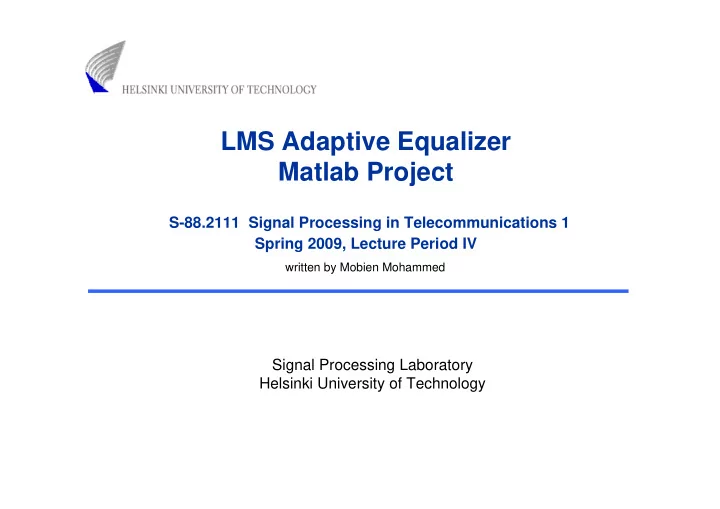

LMS Adaptive Equalizer Matlab Project S-88.2111 Signal Processing in Telecommunications 1 Spring 2009, Lecture Period IV written by Mobien Mohammed Signal Processing Laboratory Helsinki University of Technology
Outline 1. System Model 2. Channel Model 3. Adaptive Equalizer 4. Simulation Model 5. Sample Demo System 6. Practical Issues S-88.2111 Signal Processing in Telecommunication I (3 cp)
1. System Model n k r k x k q k z k Channel ∑ Source Equalizer Slicer - e k ∑ + Delay S-88.2111 Signal Processing in Telecommunication I (3 cp)
2. Channel Model • FIR type of channel introduces inter-symbol interference (ISI): = + − + − + + − − 1 2 ( L 1 ) C ( z ) c c z c z ... c L z − 0 1 2 1 where L is the number of channel coefficients • Model for noise – Additive White Gaussian Noise (AWGN) with the power σ n 2 S-88.2111 Signal Processing in Telecommunication I (3 cp)
3. Adaptive Equalizer • Adaptive updating of the equalizer using the LMS algorithm = + μ h h 2 e r + k 1 k k k where input signal vector ( r k =[ r k r k -1 … r k -( N -1) ] T ) r k h k weight vector e k error signal µ step size • Mean Square Error (MSE) criterion [ ] MSE = 2 E e k k S-88.2111 Signal Processing in Telecommunication I (3 cp)
4. Simulation Model • Implementation of transmission system in Matlab – Transmitter – Channel – Equalizer – Decision device S-88.2111 Signal Processing in Telecommunication I (3 cp)
... Simulation Model %%%------------------------------------------------------------------ %%% Transmitter %%%------------------------------------------------------------------ x=sign(randn(1,K)); % Generate BPSK data. ref_x=[0*ones(1,D),x]; % Generate reference signal. %%%------------------------------------------------------------------ %%% Channel %%%------------------------------------------------------------------ for i=1:I, % Run all the indepedent runs. ['Iteration:',mat2str(i)] % Iteration index. channel_data=filter(cn,1,x); % Distort the signal. n=sqrt(sigma2_n)*randn(1,K); % Generate white noise sequence. channel_output=channel_data+n; % AWGN channel. %%%------------------------------------------------------------------ %%% Equalizer %%%------------------------------------------------------------------ [h,e,q,z]=lms(channel_output,ref_x,my,N); % Linear LMS equalizer. MSE=MSE+abs(e).^2; % Mean Square Error(MSE). end S-88.2111 Signal Processing in Telecommunication I (3 cp)
5. Sample Demo System Channel model ( W =2.9; L =3; l =0, ..., L-1 ) • ⎡ π ⎤ ⎛ ⎞ 1 2 = + − ⎜ ⎟ c l ⎢ 1 cos ( l 1 ) ⎥ ⎝ ⎠ ⎣ ⎦ 2 W • Simulation parameters Parameter Value Number of independent runs I 200 Number of transmitted symbols K 500 Number of filter coefficients N 11 Noise power σ n 2 0.001 Step size μ ( μ max /3) 0.0276 Channel coefficients [ h 0 h 1 h 2 ] [0.2194 1.0000 0.2194] S-88.2111 Signal Processing in Telecommunication I (3 cp)
5.1 Mean Square Error (MSE) Parameters: N = 11, D = 7, μ = 0.0276 S-88.2111 Signal Processing in Telecommunication I (3 cp)
5.2 Impulse responses S-88.2111 Signal Processing in Telecommunication I (3 cp)
5.3 Frequency responses S-88.2111 Signal Processing in Telecommunication I (3 cp)
5.3 Time domain responses S-88.2111 Signal Processing in Telecommunication I (3 cp)
6. Practical issues • This project is required for the course • You may work in teams of 2 • Please register your group with the assistant • Grading – Pass/Fail • Documentation – Brief report please! – Emphasize on the results rather than the already given background • Project deadline: May 29, 2009 S-88.2111 Signal Processing in Telecommunication I (3 cp)
Recommend
More recommend